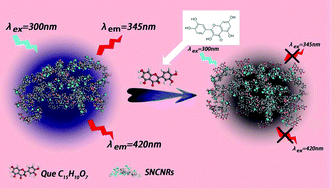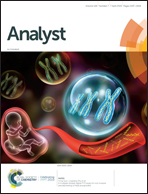Excitation-independent emission carbon nanoribbon polymer as a ratiometric photoluminescent probe for highly selective and sensitive detection of quercetin†
Abstract
In this study, sulfur–nitrogen co-doped carbon nanoribbon (SNCNR) polymers with stable dual-emission fluorescence were synthesized using a one-step traditional hydrothermal method of 6-mercaptopurine in an aqueous methanol solution. Unexpectedly, the as-prepared SNCNRs with excitation-independent emission, as carbon nanomaterial derivatives, showed stable dispersions of a reticular-like shape and different lengths in the skeleton diameter. Compared with other carbon nanomaterials, the SNCNRs dramatically improved the electronic properties and surface chemical reactivities, and exhibited a sensitive ratiometric response to quercetin (Que) because of the Meisenheimer-like complexes formed through π–π stacking and electrostatic interaction. By using this SNCNR sensor, excellent ratiometric linear relationships (FL345 nm/FL420 nm) existed between the degree of quenching of the SNCNRs and the concentrations of Que in the range of 50.0 nM to 200 μM, and the limit of detection was 21.13 nM (3σ/k). Meanwhile, this sensor shows high selectivity for Que over other biomolecules, most amino acids and metal ions under the same conditions. Finally, this fluorescent probe was successfully applied to the direct analysis of Que in bovine serum and some beverage samples, which showed that it has potential for use in applications in clinical diagnosis and food analysis, and may pave the way for the design of effective fluorescent probes for other biologically related targets and food protection.

- This article is part of the themed collections: Optical Biosensor Devices and Bioanalytical Sensors


 Please wait while we load your content...
Please wait while we load your content...